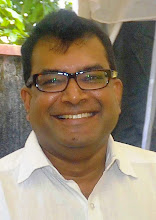– A jointly organized, by the Marga Institute and the Gamani Corea Foundation, held at the BMICH on 30th January 2017
The keynote speaker was Professor Buddhi Marambe - Professor of Crop Science of the University of Peradeniya along with three other speakers.
A synopsis of each of the talks will be
available shortly at the Marga Institute Blog
I will not go into any detail on each
talk but merely comment on what I managed to glean from the various talks to
form my personal opinion on the matter and would invite comments on interested
readers on my conclusions.
The overriding theme was the fact that
in light of the unpredictability of the climate, with a yearlong drought that
we are experiencing as a backdrop, we have to take certain steps on the
assumption that this is the norm, to ensure food security for the people who
live in Sri Lanka.
Against this need, the current
unscientific policy making by those in power, effectively relegating the whole
of the Agricultural Community, academics and the private sector to the dustbin,
the infatuation with CKDU and the fundamental misunderstanding about its cause
and effects as well as the hell for leather theme of “WASAVISAN THORA RATAK”
whilst appealing to the public, is a flawed concept if we are to ensure FOOD
SECURITY in the short term.
It is the simple fact that if one takes rice for
example, where the yields of traditional varieties are at best 25% of the
present, it is courting disaster if we are to adopt this as a national policy!
The proponent of the policy, being the Venerable Rathana Thero, who has
influenced the President to adopt this approach without ANY consultation with
the scientific or farming community, is a very dangerous route, nullifying the
enormous gains on productivity achieved in Sri Lanka between 1946 and 2015 to
go from food deficit to food surplus, putting this achievement in jeopardy.
It is therefore important to understand
the basics of FOOD SECURITY and need thereof, before making irrational short
term policy directions in areas like banning glyphosate, where Sri Lanka is the
ONLY country on the face of the Earth so to do
Whilst the word organic is bandied about
without any real practical means of how to achieve anywhere near required yields,
this food can at present ONLY be indulged in by the haves. It is the(BAP) BEST
AGRICULTURAL PRACTICES that need to be adopted without delay to lend
credibility to the food we consume.
In consideration of climate changes, it
was pointed out that our dry zone rainfall can be referred to as wet zone
rainfall in some African Countries, and we have to be more aware of means to
produce yields with minimal water requirements, and to that extent low water
use crops must be encouraged, and if necessary the whole aspect of nutrition
revisited, where we consume less rice, and more vegetables, by these alternative
practices, to improve nutrition, and change consumption habits to ensure a
healthy populace.
In that context a holistic approach that
ties in Land Use, Land Consolidation, Soil Conservation and Regeneration, Awareness
of the acute shortage of agricultural workforce, more mechanization, Crops that
reduce the need for water, Change consumption patterns to improve health and
nutrition, Plants that have higher profitability to ensure a minimum income
exceeding Rs50K a month, adding a third crop in certain instances, and using
fallow land in the Colombo District for high value products for export, are but
a few of the areas that require more input.
The benefits of commercial farming
techniques, with use of new technology to meet export needs in niche markets
was also elaborated upon by Mr Rizvhi Zaheed of Hayleys Agriculture with
examples from their current practices.
It is clear that the scientists and the
incredible expertise already existing within the Agricultural Department, along
with emphasis of new and Best Agricultural Practices to encourage the numerous
Agriculture Graduates to go into the field, rather than into non-related fields,
and ensuring their influence in the Policy making framework is an essential ingredient
to ensure a successful future for Agriculture to ensure Food Security in Sri
Lanka.
A point NOT discussed was the need to strengthen
land ownership and titles, so that more land can be released for cultivation,
with the assurance that land will not be lost if rented to professional
farmers, who can consolidate land into contiguous areas for efficient farming.
Another area that had little discussion was the value or harnessing and storing
water, to be used sparingly, to ensure minimal wastage, as well as the required
use of fertilizer and pesticides to minimize leaching using drone technology to
pin point specific areas of use, instead of the whole field.
Finally a gentlemen who had retired from
the FAO, who was now over 80 gave a clear demonstration that our food intake
was at fault, with ideas for improved nutrition and use of much less starch
like rice in one’s diet, that over time could change the habits of the whole
Country, to a healthier lifestyle, and use of much less inputs to achieve much
more in terms of a wholesome nutritious diet in future!

















